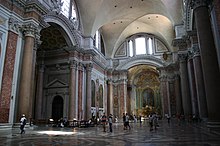Santa Maria degli Angeli e dei Martiri
| Basic data | |
|---|---|
| Patronage : | Santa Maria degli Angeli e dei Martiri |
| Cardinal priest : | Arborelius OCD is different |
| Address: | Piazza della Repubblica 00185 Roma |
The Basilica of Santa Maria degli Angeli e dei Martiri is a church in Rome . It is located in Piazza della Repubblica near Termini train station . It is a titular church of the Roman Catholic Church .
History and description
The church was built in the ruins of the Baths of Diocletian . The portal of the church is located - exactly opposite the main entrance of the former thermal baths (6) - on the former inside of the caldarium (1), of which only ruins can be seen today, but which on the portal result in a unique viewing side and clearly the conversion reveal. The portal leads into the interior of the church, which begins with a vestibule that is integrated into the former tepidarium (2) of the thermal baths and then merges into the church building, which corresponds to a large part of the frigidarium (3).
The church looks comparatively cautious about the thermal bath architecture of antiquity. The Palaestrae (5) flanking the former frigidarium and the natatio (4) to the northeast are now largely built over. The large exedra (7), on the other hand, is still shaping the Piazza della Repubblica today.
Pius IV had given the monks of Santa Croce in Gerusalemme the use of the ruins. Work began in 1563 under the direction of Michelangelo . The floor level had to be raised by 2 m, which meant that the antique column bases had to be replaced by new ones. However, the monolithic columns made of Egyptian red granite and the groin vaults still come from the earlier thermal baths.
From 1748 the church was renovated according to a design by Carlo Murena . The original main nave became the transept of the rebuilt church, resulting in a completely different spatial impression.
Many important figures in Italian history are buried in the church, including Armando Diaz and Paolo Thaon di Revel , and the baroque painters Salvator Rosa and Carlo Maratta .
The Linea Clementina

Particularly noteworthy is the meridian worked into the floor with scientific precision . This almost 45 meter long bronze line served as a gnomon and was a reference point for mathematical and astronomical calculations. It made it possible to read the equinox in spring and thus determine the date of Easter . At the same time, it should illustrate the reliability of the Gregorian calendar . Shortly after his election in 1700, Pope Clement XI. set up a commission to review the Gregorian calendar. Their nominal chairman was Cardinal Enrico Noris OSA (1631-1704). The factual management of the papal calendar commission, including the calculations required for adding the noon line, was taken over by the mathematician, astronomer and canonical secretary Francesco Bianchini . This "Linea Clementina" was on October 6, 1702 by Pope Clement XI. handed over to their destination.
organ
The organ was built in 2000 by the organ builder Barthélémy Formentelli (Valpolicella, Veneto). The instrument is a gift from the Romans to Pope John Paul II on the occasion of the “Grande Giubileo 2000”. The organ case is made of wild cherry wood. It is 12 m high and 11 m wide. The instrument has 77 registers (5400 pipes ) and an effect register on four manuals and pedal . The playing and stop actions are mechanical.
|
|
|
|
||||||||||||||||||||||||||||||||||||||||||||||||||||||||||||||||||||||||||||||||||||||||||||||||||||||||||||||||||||||||||||||||||||||||||||||||||||||||||||||||||||||||||||||||||||||||||||||||||||||||||||||||||||||||||||||||||||||||||||||||||||||||||||
- Pair : I / II, III / II, III / P
- Playing aids : combinations, Usignolo
See also
Individual evidence
- ↑ www.santamariadegliangeliroma.it
- ↑ Valentin Kockel , Brigitte Sölch (Ed.): Francesco Bianchini (1662–1729) and the European learned world around 1700 . Akademie-Verlag, Berlin 2005. ISBN 3-05-004133-1 . P. 22.
- ↑ More information on the organ (Italian), see also the information ( page no longer available , search in web archives ) Info: The link was automatically marked as defective. Please check the link according to the instructions and then remove this notice. to the organ (German)
- ↑ To the disposition (Italian)
- ↑ Information on the organ
Web links
Coordinates: 41 ° 54 ′ 11.4 " N , 12 ° 29 ′ 49.1" E





